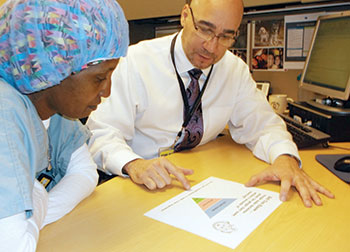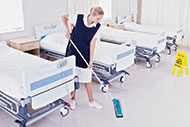 |
|
PHOTO BY ISMAEL SILVA One-on-one coaching with staff members helps them to make a great first impression. |
Patient satisfaction is driven largely by employee satisfaction. Unfortunately, the term “employee satisfaction” is one of the most overused and least understood phrases in the environmental services (ES) profession.
A good majority of leaders have been led to believe the gateway to improving employee satisfaction is through superficial rewards and recognition.
Although this can be effective at moving scores from low to acceptable, it is perplexing that there often will be large fluctuations in scores. Patient units sometimes will reach high scores one month only to produce a score barely out of the 60s the following month; while other units either maintain high scores or persist in low scores.
There are successful leaders across the United States who have sustained achievement in driving HCAHPS scores from low to well above the national average, usually with very little money dedicated to recognition programs. In fact, truly successful leaders employ strategies that do not toss money at the problem.
Resounding traits
There is a resounding trait that each of these leaders possesses and, although it may sound obvious, most leaders do not demonstrate this essential quality to the degree that is necessary for success.
These leaders genuinely care about each person not only on their teams, but those with whom they come into contact throughout the day. This inherent caring for fellow human beings is the driving force behind their success.
The path each facility follows to reach desired outcomes can be unique for each team because no two corporate cultures or synergies are identical. The most important aspect is how leaders positively connect with each staff member to identify what is important on an individual basis. Once identified, a protective layer of respect needs to be applied to this understanding, while newly acquired knowledge is used only to guide positive outcomes. This is the very moment when a staff member ceases to feel like another member of a group and officially assumes his or her role on a team.
About this seriesThis series of tutorial articles is a joint project of the Association for the Healthcare Environment and Health Facilities Management. |
Some industry experts will suggest placing the best staff on units where the most surveys are received. This is a good approach if the leader wants to raise scores to a relatively high position for a short period. But when staffers fall ill and leaders are forced to use second-stringers, fluctuations show up in scores. The best approach to avoid drops in scores is to develop all staff members without bias. Backup players should be qualified equally to be in the game as starting players.
Most health facilities professionals understand the term “leader” to mean the director of a department or group who holds the most power and makes final decisions. However, leaders also are assistant directors, operations managers, supervisors and team leaders — basically, anyone who provides direction to another. ES departments have more than one leader and each one of these job titles comes with a specific responsibility under the leader umbrella. Regardless of title, the most important function of each leader role is that of listener.
The HCAHPS score has evolved into a reality check for how well leaders hear what is important to their respective staff and how effectively ideas and suggestions are acted upon. Leaders with good listening skills have much happier staff than leaders who have this essential quality highlighted as an area for improvement on the managerial checklist.
Ever since the emphasis on infection control has raised the importance of ES performance, there has been a tendency to latch onto accomplishments from other industries. Lean Six Sigma processes made their way into professional cleaning and disinfection several years ago. This fancy term for finding a way to do more with less helped to sensationalize the low-budget movement. Along with this came the concept of solving problems through root cause analysis.
If taught and applied correctly, this strategy is generally the key to understanding why problems exist in the workplace. The principle behind this concept is simple — what is to be fixed must first be understood completely. From this understanding, meaningful plans of action can be put into place to achieve results.
All too often, ES leaders place a white dot outlined by a red circle on the wall and blindly shoot notions and concepts toward the center to see what sticks. Programs and initiatives evolve and are implemented as a way of occupying the leader’s time in the hope of demonstrating worth. What is more worthwhile is adoption and adherence to a problem-solving methodology that doesn’t hinge on chance.
Also, too often, nursing is blamed for low cleaning scores. This interferes with the ES leader’s ability to identify the real reason for the low HCAHPS scores and to start addressing the issue at the root. If nurses are believed to be part of the problem, then they should be made part of the solution. On this journey to the root cause, ES leaders generally will find nursing to be more of a partner in the crusade to improve HCAHPS scores than the reason for low scores.
Some ES leaders even may have tricked themselves into believing that the problem lies with those completing the HCAHPS survey. However, it is implausible to believe that everyone in a geographic region is inherently miserable. No reason is going to be acceptable when peers in similar situations have prevailed.
Excuses made for reasons why HCAHPS are low only further prevent any movement forward. Concealing the true cause just delays the inevitable.
Enlisting staff
Rather than deciding how to increase HCAHPS scores and then forcing initiatives onto the staff, ES leaders should consider leaving the strategy of how to increase HCAHPS to the individuals who have the most influence over these scores — the front-line workers.
Staffers who are involved in process improvement will identify ways to increase scores that are beyond what leaders may deduce as the root cause to low scores. Front-line ES staff members are the eyes and ears of a health care facility. If ES leaders truly want to know what is or isn’t happening in the field, they should ask front-line staff. However, staff will only be truly honest with leaders if there is a relationship built on trust and integrity.
Management by walking around (MBWA) is an old manufacturing technique used to forge trusting relationships between leaders and staff. It sounds simple, but there is a science behind how leaders engage with staff. Several years ago, MBWA started to make an entrance into the professional cleaning world, but was poorly understood by many of its adopters.
What was once designed to be a free, nonconforming, non-regimented engagement with staff turned into a heavily paper-driven, quota-based task for leaders, ultimately making for an unpleasant experience for everyone involved. Resurrecting and properly applying MBWA could be the positive foundation necessary to help jumpstart upward-trending HCAHPS scores.
Another overutilized and poorly understood phrase in the health care industry is that of “engaged staff.” Staff engagement has become a catchphrase for defining what we believe the ideal staff member to be — someone who has good attendance and follows all the policies and procedures created by leaders. If we were to draw the ideal staff member, the picture would very much resemble a robot. We all know how efficient robots can be, especially at meeting metrics and expectations, but they often lack the skills and abilities to think independently.
What has been called engaged staff should really be referred to as involved staff. Once staff members start to become involved, engagement is a positive byproduct. Involvement doesn’t mean giving staff control over something that doesn’t matter to the majority. It means providing the necessary autonomy and latitude during decision-making for someone that is your equal.
Although a hierarchy exists in every organization, only those in which titles are not as apparent are the most successful. Flatter organizations have a greater tendency to achieve a level of equality that bridges gaps within the ranks. That doesn’t mean multiple titles are not in existence. It means that people occupying those positions understand the power each title wields and exercise their authority with respect and admiration for others during all interactions.
Front-line staff members are the sales force for a facility and its services. Developing a knack for sales requires a specific skill set, achieved only through education. It is essential that leaders articulate the desired outcome and then provide the tools and latitude necessary to reach the established bar. Transformational leaders mold their environment into the Wall Street of ES operations. Everyone is awarded figurative stock in the company with open forums to trade ideas freely. This investment creates the foundation for dedication and commitment that naturally supports a common goal.
Future-focused leaders look for ways to get the creative juices flowing in staff. The walls and silos are coming down. This new breed of leader eliminates suggestion boxes and employs cross-functional teams, think tanks and brainstorming sessions that allow staff an opportunity to engage openly and freely in idea and suggestion development. Staff members who once were thought to be part of the problem now become part of a forward-moving process.
Involving staff and treating them as equal means avoiding judgmental practices that presume information will be too complicated for staff members to understand. That once-protected budget is now posted in corridors for all to see and review. Five-year goal plans are not just for presentations to senior leaders. This information should be shared with the troops so they know which direction to march. Some even may provide intelligence that could help to avoid land mines. A little more time on the front end will save much time, aggravation and inefficiency on the back end.
Finally, archaic scripting is out the window. Role-playing and reviewing situational results are preferred ways to prepare staff. If staff members learn how to interact effectively with the individuals who ultimately control the numerical values awarded on HCAHPS surveys, the end result is inevitably higher HCAHPS.
Hands-on, largely computer-based learning becomes fun and interactive. These new techniques remove some of the stress and overcome retention issues from information overload associated with historical and textbook learning. The adoption of e-training allows the learner to revisit material easily whenever necessary, along with providing a virtual environment in which to become comfortable.
A direct correlation
There is a direct correlation between employee satisfaction and HCAHPS. If leaders focus efforts on improving employee satisfaction by updating their own leadership style and strategies, the end result will be a sustained increase in HCAHPS performance.
Tanya Henry is a consultant at Iconic Oak LLC, Rochester, N.Y. She can be reached at Tanyam@ioakc.com.






